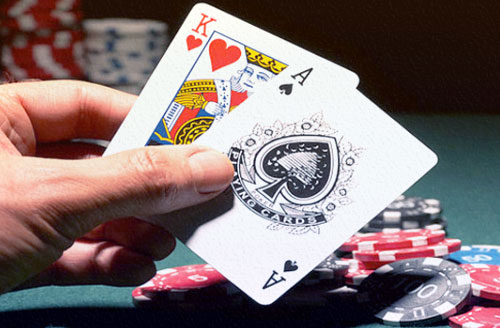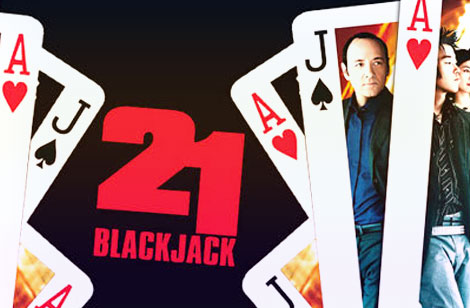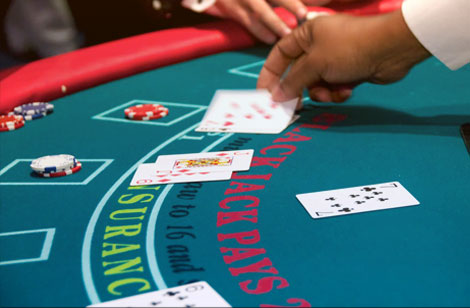Are you tired of poker card games? Learn the basic rules of blackjack with us. After our guidance, you will play the game like a pro.
Blackjack Rules
Well, since you Googled this topic, it’s only natural for us to assume you either want to get better at this card game or learn about it. Either way, we rush to your aid, so worry not, because we are going to break this down in the easiest possible way. The game of blackjack and how to play it will come naturally after this. Besides poker, you can find no other game as popular as blackjack. In fact, these two card games are the first ones that pop to our mind when we mention table games.
Ok, since no one can build a house starting from the rooftop, we need to make a solid foundation before we begin with the blackjack card rules. Any serious blackjack player will inform you that this game is better known as Twenty-One. What gives the extra kick and attracts the players worldwide is that you don’t need to defeat other players.
The only real foe in this card game is, none other than the dealer. One of the things blackjack can’t exist without is a deck. Other than these couple of things you should know, the gameplay itself is pretty simple and thrilling. There are even some very successful strategies you can use, but we’ll discuss this later on.
Moreover, in order to master these techniques, other than just pure knowledge about the game, you need to use a few mathematical skills. If you are talented for math, you can actually put that knowledge to decent use and become an expert who can count cards. This way, your odds improve a bit, which is the primary goal of every card game player.
The Origins and History of Mr. Blackjack
Other than the name which sounds very cool and badass, not many people show interest in how this game was created. But we believe a successful player has to be well aware of every aspect of the game. Hence, we decided to be extra thorough and provide you with all the information there is to know. That being said, we can now proceed to the interesting history of the game and then to blackjack card rules.

This topic is heavily debated. Some claim the origins of blackjack go back to 17th century Spain. But the fact remains that no historian can claim with certainty where this game was created precisely. However, there are some clues that show us its history from a better perspective.
Namely, there were several games we found across the globe which are highly likely to have influenced each other over an extensive period of time. Ultimately, the mixture of all of them created the blackjack game we all know and love today.
The first clue we have found when searching for the roots of blackjack was the one in the 1600s. The Game of 21 was mentioned then for the first time, and Miguel de Cervantes wrote the book “Ronconte y Cortadillo.” This book mentioned the Sevillian gamblers who cheated.
Fast forward to 1700s France, a game “Vingt-et-Un” is the one we connect to today’s game. Unlike the Spanish version which had a similar set of rules, the French one used thirty-one cards. When the colonists from France crossed the great pond in the early 1900s, blackjack was a hit. It spread like wildfire. Naturally, some rules were bent, and we finally got the modern version sometime during the 1930s in Nevada.
Home Version VS. the Casino Gameplay
All of these modifications made blackjack a card game you can find in every, and we mean every possible casino, both land-based and online. But this game has a home variant too. It is, however, played by a slightly different set of rules.
Casinos use a ‘permanent bank,’ or the house dealer. This person is the one in charge of running the game. This individual stands as the game evolves, while all players are seated. Dealing, handling the bets, and shuffling — the dealer is the only one who can execute these actions. A home variant offers every single participant a chance to be the dealer or a ‘changing bank.’
The Deck
At every table with blackjack, we can only find the standard 52-card decks. However, most North American casinos use multiple decks and shuffle them together. One of the most common mixtures includes six decks combined into one, arriving at a total of 312 cards.
As an addition, the dealer is using a special plastic card. Don’t worry, because this addition is never dealt. The reason the dealer uses it is to help with the shuffling of new cards, as an indicator that the time is right to mix the cards. This plastic one is always at the bottom of the deck.
Now, every time the casino decides to use more than four decks, a dealer’s shoe is used. It’s not an actual shoe people wear on their feet. This term represents a plastic box-like device that allows the dealer to take away one card at a time facing down.
The Objective of Blackjack, Card Values, Scoring, and Betting

How can you play blackjack if you don’t know its objective? Well, the goal is pretty straightforward — reach the number twenty-one before the dealer does, it’s simple, right? Wrong. This sounds so easy, but the reality is far from it.
Just remember, the number you end up with has to be as close to twenty-one as possible, but if you end up under this number, you remain in the game. On the flip side, if you happen to go above this figure, you will lose. The dealer is in the same sauce.
In this case, just remember our golden rule — less is more. Never exceed 21, period. Any higher figure will mean your demise. But first, you need to learn a thing or two about the card values, so you can know how to count cards in blackjack accurately.
Basically, it is up to an individual player to decide if an Ace is worth one or eleven. All of the Face cards represent a ten, and all the other cards retain their inherent values. Memorize this. It will be your guiding light. If you forget the values, you can never beat the dealer.
Now, before the first card is dealt, you must place an original bet in the form of chips in front of the dealer. You put the bet in the marked area. The layout of the table makes it very easy to find your way even if it’s your first time sitting there. Blackjack rules have nothing to do with the betting limits; it’s up to the particular casino you play at, and the range is between $2 to over $500.
The Cut, the Shuffle, and the Natural
Once you have placed a bet, the dealer will proceed to shuffle the deck. Right after all of the cards are combined and mixed well, you get to the cut. Remember we mentioned the plastic card? Well, at this point, this item is placed in a manner that the last sixty or so cards are off-limits (not in usage yet). This is done to prevent any professional blackjack card counting from taking place.
And now, we come to the dealing process. Once you, and possibly some other players, place your bets, you shall all receive the first two cards face up in the clockwise direction. The dealer will also give one card to the house. This one will be facing up so everyone can see it. An important thing to mention — only the first dealer’s card will be exposed, and the second one will remain hidden, unlike the two that were distributed to you. The final result — you have two cards face up, and when it comes to the dealer, their one card is face up so you can see it and another one is left to your imagination.
The Natural
This leads us to the next important term and a possible situation in the game — a natural. In a nutshell, if you have received a ten-card (picture cards count as a ten) and an Ace, what is your score? Since we talked about card rankings, it’s easy to calculate that the final result is the magic number of twenty-one.

What does this number mean? You got yourself the best freaking combination in the world; the prize is yours because, my friend, this is called a ‘natural’ or a ‘blackjack.’ Now, you should rejoice in case you have the delicious combination, but if the dealer has it, you’re doomed. But hey, you always have a fifty-fifty chance in games of chance. You either win, or you lose.
You will get your whole bet back and another half in case you have a natural. In case the dealer receives a natural, they collect the bets from all the players, but no more than that. If both of you end up having the score of twenty-one, that is a tie, and you can take your chips back.
The dealer will take a look at the hidden card if the one exposed is a ten or an Ace to check whether they have a natural. If not, the second card won’t be checked until it’s the dealer’s turn to play.
The Gameplay
If you aren’t the only person participating, the player who sits on the left will decide whether they won’t demand another card (the ‘stand’) or will ask for a new one (the ‘hit’). It all depends on the cards this player received and how close those are to twenty-one. Hence, you can stand on the original two ones, or ask for some additional cards.
You can ask for one card at a time until you consider the number to be close enough to the desirable total. Just remember — never go above twenty-one. If you happen to get a high card, and your score jumps over, you’ll go ‘bust’ is what’s going to happen. Bust means you are in over your head, and it’s game over for you.
The hand combination of any other card than a ten and an Ace is called a ‘soft hand.’ And it is more often than not that you’ll have this combination. You can either count an Ace as one or eleven. For instance, let’s say you have an Ace and a six before you.
You can count them as a seven or as a seventeen. While the second scenario is a strong hand, you might want to get even closer to twenty-one and choose to receive a new card to chase after a higher figure. In case you get a bust, you can still manage to count an Ace as a one and continue playing by hitting or standing. So, you see, a soft hand is actually a good solution. It certainly saves you from the bust.
When it’s dealer’s time to play (after serving each player), the long-hidden card that tormented you for so long is ready to be revealed. Hold your breath. If the card is seventeen or higher, the dealer has to stand. On the flip side, if the dealer’s total turned out to be sixteen or lower then another card must be drawn. The dealer has to draw until the total is at least seventeen or more, and at this point they must stand.
If the dealer happens to have an Ace, and if counting it as eleven would bring them seventeen or more than that, but less than twenty-one, an Ace has to be counted as eleven. Thus the dealer must stand. This means that the decisions the dealer makes are always automatic. The rest of the players have the possibility to take one or several more cards.
Blackjack Hand Gestures
If you want to appear as a professional, you should learn the silent lingo behind blackjack card rules. This one is a piece of cake. When it’s your time to play, you can choose to say ‘hit’ or show the dealer this decision by making a hand gesture. By the way, we think it’s much cooler to use your hands than words. Signal it by scratching the blackjack table with a single or two fingers. You need to make a scratching motion toward yourself, as you would invite someone to ‘come over.’

On the other hand, if you want the opposite, i.e., to ‘stand,’ you can move your hand sideways. Place your palm down but just above the cards table. See, blackjack hand gestures are as easy as pie.
Splitting Aces and Doubling Down
If your first two cards just happen to be of the same value, e.g. two sevens or two Queens, you can choose to split them when it’s your turn. This can be a good blackjack strategy at times. Nevertheless, this also means that your original bet transfers to just one of those cards, and you must place an additional equal bet to the other one. You must play your left hand first, and do so by hitting or standing at least once. It’s only after these acts that you’ll be allowed to play the right one.
This way, your two cards are treated as completely separate hands. The dealer basically treats them as separate players. If you have a pair of Aces, you are given one more card for each Ace, meaning you can’t draw anymore.
Another option you have is to double down. This is your option when you receive the initial two cards, and they make a total of either eleven, ten, or a nine. You can double your bets in this scenario. Once it’s your turn to play, you can increase your original bet with an equal amount of money. The dealer will give you a single more card, however, this one will be hidden. You will be able to check this one once the bets are settled and the hand has ended.
If you have two fives, you can always double down, split a pair or choose to carry on with the hand in a regular way. Bear in mind that the dealer doesn’t have the option to use the split or the double down.
The Insurance Bet, Settlement, and Reshuffling
If the dealer’s card which is visible to you is an Ace (the revealed, face up one), you can make a side bet. This one can go as high as half the amount of the initial one. It’s called insurance. After you make a choice to place this kind of a bet, the dealer will take a look at the hidden card. If this one turns out to be a ten, this card is revealed, and you win. This is not just a win. You will receive double the amount of your half bet. It will be a two to one payout.
And even though this might seem like a basic strategy to ensure you some extra money, we consider this to be on the risky side. So, this is something we like to avoid. In case the house has a blackjack, they will take away all your chips of the main bet. The dealer has the advantage over you since you act first. If you go bust, you lose your wager, even if the house goes bust as well.
After all the bets are settled, the dealer will gather all the cards and place them against the plastic shield. They will continue to distribute the cards from this shoe until the plastic card pops up. This indicates that it’s time to reshuffle. Once the round is complete, the cards will be shuffled and prepared for the second cut.
Most Popular Blackjack Strategies
Now we are getting close to somehow wrapping this whole thing up. Ok, so when you master these rules, and only then, will you be able to think about a blackjack strategy. In order to have a strategy that works, you have to play in the most optimum way. This can only be possible if you take the dealer’s face up card into consideration. If this card is a solid one, like an Ace, a ten, a nine, an eight, or a seven, you shouldn’t stop drawing until the final of a seventeen or higher is reached.
On the other hand, if the dealer’s card is a lousy one like a five, a six, or a four, as soon as you reach twelve or higher, you should stop drawing. The key to this strategy is to never take the card if there’s even a slight chance of a bust. The primary thing is to hope for the dealer to hit and pass twenty-one. If the dealer’s exposed card turns out to be a three or two, you should stop drawing once you get thirteen or more.
Now, in a soft hand scenario, the best strategy is to just keep on hitting until you reach at least eighteen in total. You are probably waiting for the popular card counting technique at this point. Well, we think this might just be a bite too big to chew.
Thus, we’ll have to leave it for some other occasion. Until you master the basics, there is really no need to go down that road. Yet. Just practice all of the above with your friends or family before you make a decision to hit the casino gaming floor. Once you start your first real money blackjack match, you will never go back. The magic of blackjack will put you under its spell. Hopefully, you will become the best player you can possibly be.
